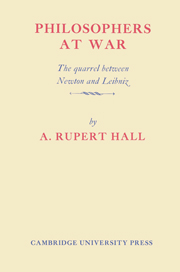Book contents
- Frontmatter
- Contents
- Preface
- Chronological Outline
- 1 Introduction
- 2 Beginnings in Cambridge
- 3 Newton states his claim: 1685
- 4 Leibniz encounters Newton: 1672–1676
- 5 The emergence of the calculus: 1677–1699
- 6 The outbreak: 1693–1700
- 7 Open warfare: 1700–1710
- 8 The philosophical debate
- 9 Thrust and parry: 1710–1713
- 10 The dogs of war: 1713–1715
- 11 War beyond death: 1715–1722
- Appendix: Newton's “Account of the Book entituled Commercium Epistolicum”
- Notes
- Index
5 - The emergence of the calculus: 1677–1699
Published online by Cambridge University Press: 16 October 2009
- Frontmatter
- Contents
- Preface
- Chronological Outline
- 1 Introduction
- 2 Beginnings in Cambridge
- 3 Newton states his claim: 1685
- 4 Leibniz encounters Newton: 1672–1676
- 5 The emergence of the calculus: 1677–1699
- 6 The outbreak: 1693–1700
- 7 Open warfare: 1700–1710
- 8 The philosophical debate
- 9 Thrust and parry: 1710–1713
- 10 The dogs of war: 1713–1715
- 11 War beyond death: 1715–1722
- Appendix: Newton's “Account of the Book entituled Commercium Epistolicum”
- Notes
- Index
Summary
Newton'sSecond Letter was retained in London for lack of a safe means of conveyance until May 1677 and only came to Leibniz's hands in late June, eight months after it was written and about as long after Leibniz had settled in Hanover, in the new world where he had to make his career. It was, he acknowledged to Oldenburg, a “truly excellent letter … I am enormously pleased that he has described the path by which he arrived at some of his very elegant theorems.” And he reiterated his praise of Newton's results throughout the letter – no evidence here of a sense that anything had been begrudged him. Before turning to series again, Leibniz took up Newton's brief allusion to the method of tangents, leading on to the anagram (which Leibniz does not mention), and in doing so expressed “publicly” for the first time (unless in informal private communications) his calculus notation; dx, he said, is the difference between two closely related values of any changing quantity x, and dy the corresponding change produced in a second variable y, which is related to x by some mathematical expression. Then if dx is constant, dy will define the slope of the tangent at x.
- Type
- Chapter
- Information
- Philosophers at WarThe Quarrel between Newton and Leibniz, pp. 70 - 109Publisher: Cambridge University PressPrint publication year: 1980



